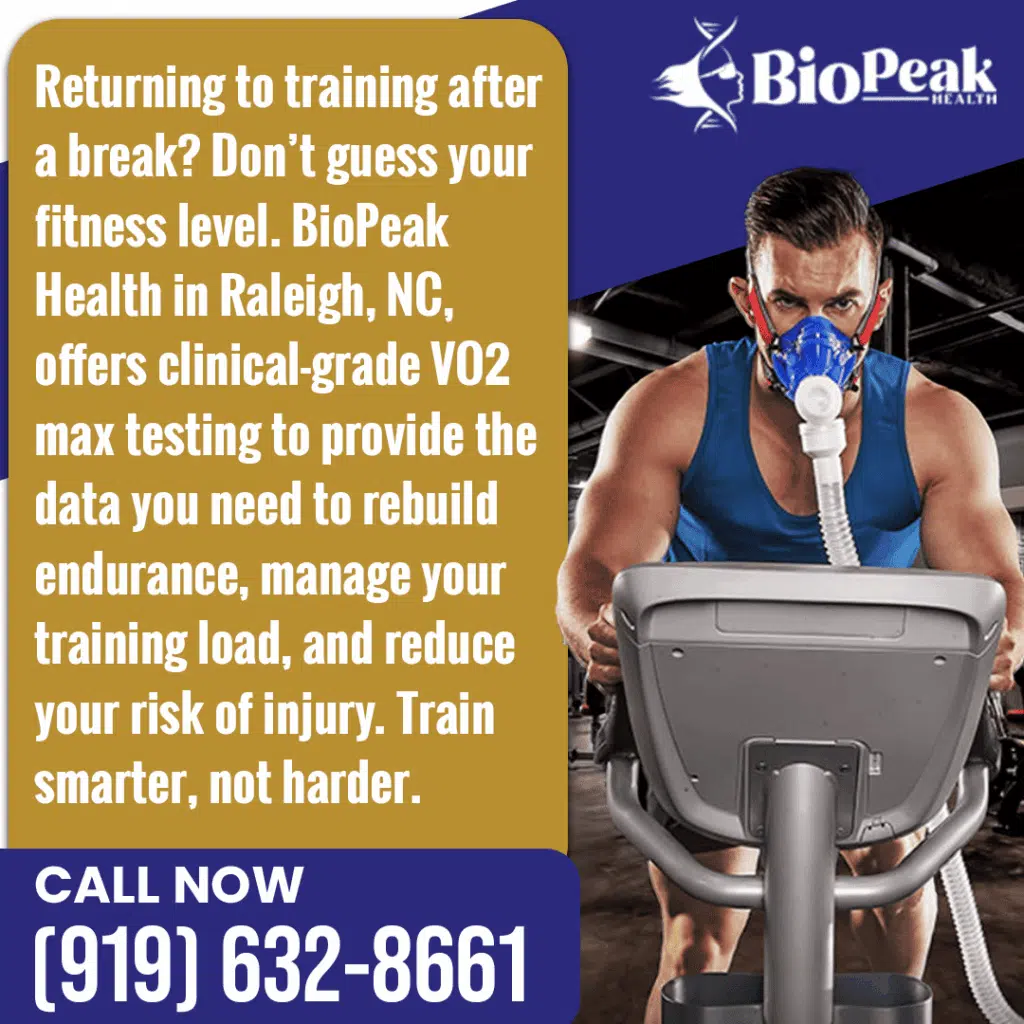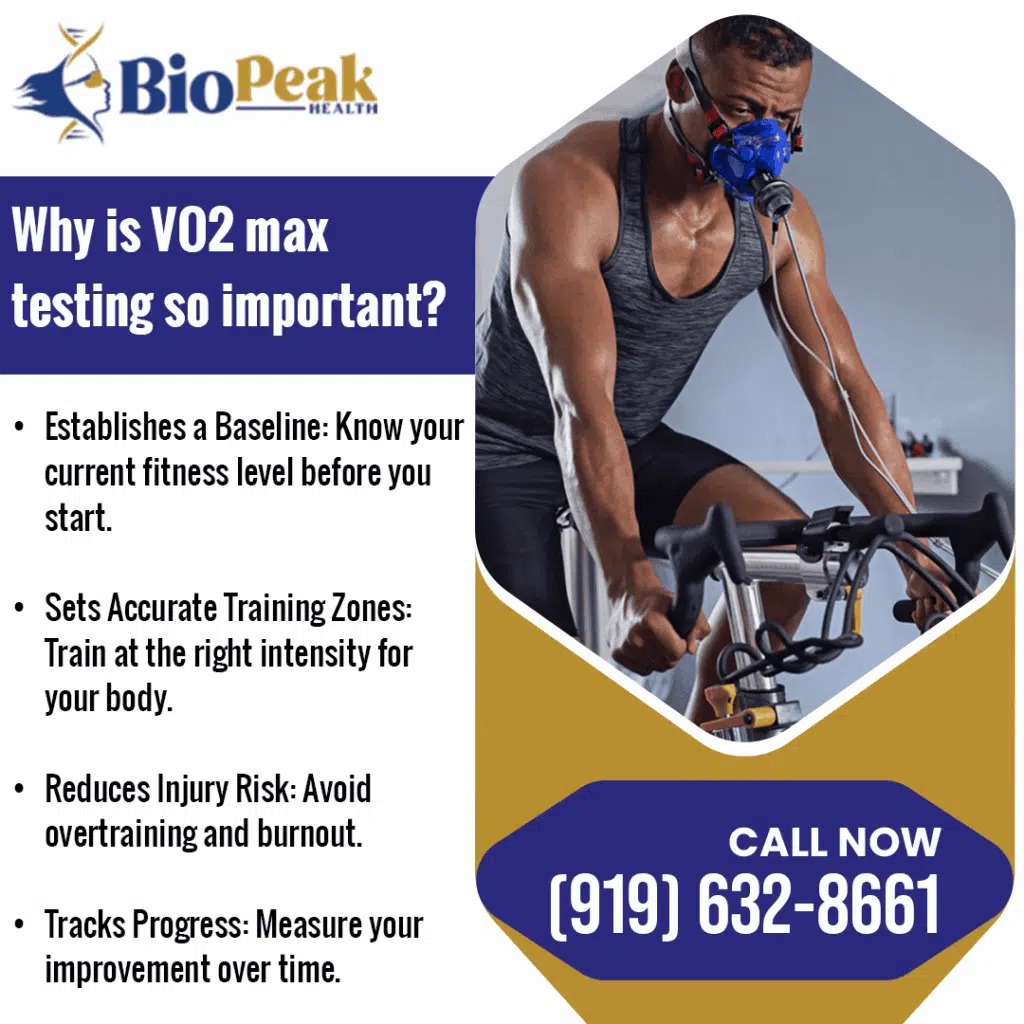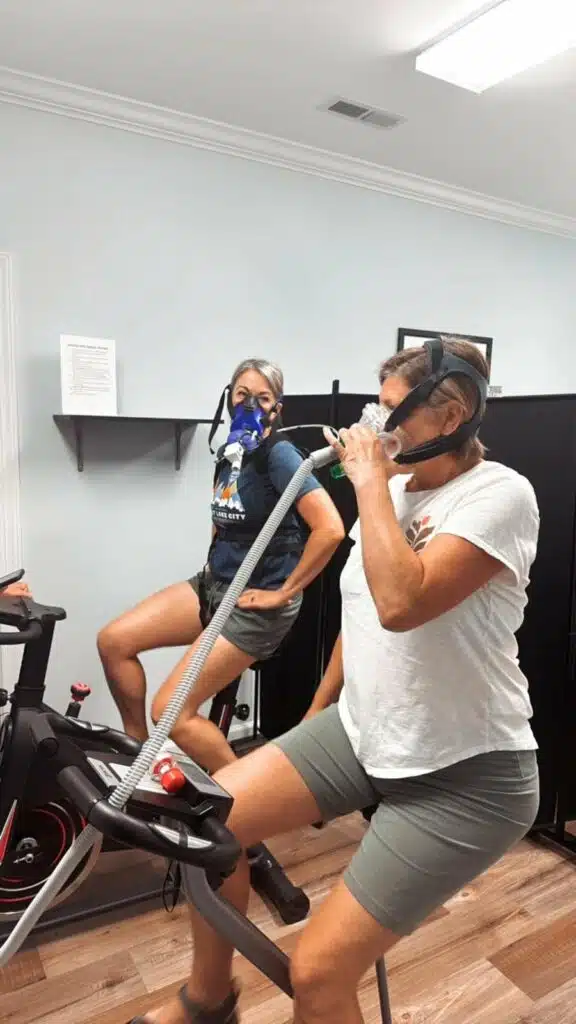Returning to a training routine after a period of inactivity presents measurable physiological challenges that can compromise performance and increase the risk of injury. Periods of rest, whether due to illness, lifestyle changes, or other interruptions, reduce cardiovascular capacity, muscular efficiency, and overall aerobic endurance. Without an objective assessment of current fitness levels, individuals are likely to underestimate training intensity or overestimate recovery capacity, which can lead to fatigue, strain, or setbacks in achieving fitness goals.
At BioPeak Health, we provide VO2 max testing in Raleigh, NC, that delivers precise evaluations of the body’s oxygen utilization during exercise, giving our clients a reliable foundation for safely resuming their training. The test measures aerobic capacity, heart rate zones, and metabolic efficiency, helping us create tailored recommendations that align with each individual’s current physiology. We help clients rebuild endurance, protect cardiovascular health, and restart training programs safely.
The Challenge of Returning to Training After Time Off
Cardiovascular and muscular performance decline after inactivity. The heart, lungs, and muscles adapt to lower activity levels, reducing aerobic capacity, muscular strength, and endurance. Research indicates VO2 max can drop after just a few weeks of inactivity.
Deconditioning limits oxygen use, endurance, and energy recovery. Reduced oxygen delivery to muscles lowers stamina and delays energy recovery post-exercise. Muscles rely more on anaerobic pathways, increasing fatigue during workouts that were previously manageable.
Resuming training without objective data can increase fatigue and injury risk. Without knowing current VO2 max and aerobic thresholds, individuals may overtrain or undertrain. Overexertion stresses the cardiovascular and musculoskeletal systems, while insufficient intensity slows progress and recovery adaptation.

What VO2 Max Testing Measures
VO2 max, expressed in milliliters per kilogram per minute (ml/kg/min), represents the maximum volume of oxygen the body can utilize during intense exercise. This metric reflects the combined efficiency of the lungs, heart, and skeletal muscles, indicating how effectively oxygen is inhaled, transported, and converted into energy. Measuring VO2 max provides a precise picture of aerobic capacity, which is a critical factor in endurance, energy recovery, and overall cardiovascular fitness.
Testing VO2 max allows individuals to understand their current physiological state with measurable data. This data helps determine appropriate training intensity, identify aerobic thresholds, and guide a safe return to exercise after a break, minimizing the risk of overtraining or fatigue-related setbacks.
Why VO2 Max Declines During Breaks
Periods of inactivity trigger several physiological changes that reduce VO2 max. Cardiac output diminishes, lowering the heart’s ability to pump oxygenated blood efficiently, while the lungs and vascular system also adapt to reduced demands. Additionally, mitochondrial function in skeletal muscles decreases, impairing the muscles’ ability to convert oxygen into usable energy. It contributes to faster fatigue during physical activity.
These changes have direct consequences when resuming training. Reduced oxygen delivery and utilization make previously manageable workouts feel more strenuous, and overall endurance drops. Individuals often notice higher perceived effort for basic exercises, slower recovery, and plateaus in performance. This highlights the importance of objective measurement before restarting training. VO2 max testing addresses these challenges by providing clear, individualized data to guide safe and effective progression back into exercise.
How VO2 Max Testing Near You Supports a Safer Training Restart
VO2 max testing provides a precise, objective baseline that supports a safer and more effective return to training after a break. By measuring your current aerobic capacity, heart rate responses, and oxygen efficiency, individualized training zones tailored to your physiology can be defined. This makes sure that every workout challenges your body safely without overexertion.
Training targets based on VO2 max scores allow for gradual progression. Individuals with lower VO2 max after inactivity can focus on extended low-intensity endurance sessions, while gradually introducing moderate intervals as cardiovascular efficiency improves. This approach balances aerobic base development with incremental intensity increases, helping prevent plateaus, excessive fatigue, or injury.
Integrating these insights into pacing and recovery strategies supports consistent adaptation over time. Structured sessions aligned with heart rate zones and VO2 max-informed targets help clients rebuild endurance, maintain energy levels, and optimize recovery, providing measurable progress from session to session.
Tracking Adaptation Over Time
Periodic retesting tracks physiological progress and informs adjustments to training plans. Increases in VO2 max indicate improved cardiovascular efficiency, better oxygen transport, and enhanced metabolic function, which are measurable signs of recovery from inactivity.
Regularly monitoring VO2 max ensures training remains aligned with current capabilities. Retesting enables identification of adaptation plateaus or unexpected declines, allowing timely modifications to intensity, volume, and recovery strategies. Choosing VO2 max testing near you helps rebuild fitness safely, maintain sustainable progress, and achieve long-term improvements in endurance and performance.
How VO2 Max Data Reduces Risk of Overtraining and Injury
VO2 max data allows for structured and gradual increases in training workload. By knowing the precise limits of your current aerobic capacity, you can avoid sudden spikes in intensity that place excessive stress on muscles, joints, and the cardiovascular system. At BioPeak Health in Raleigh, NC, we provide individualized assessments that define safe heart rate zones, ensuring that rebuilding occurs within controlled parameters.
Improved oxygen efficiency supports faster muscle recovery and better energy management. When the body utilizes oxygen effectively, fatigue accumulates more slowly, and energy delivery to working muscles is optimized. This reduces the likelihood of overtraining symptoms, including prolonged soreness, impaired performance, and elevated risk of injury.
Cardiovascular conditioning plays a key role in injury prevention. A stronger, more efficient heart and lungs enhance tissue oxygenation, which supports proper movement patterns and resilience under physical stress. VO2 max testing highlights gaps in conditioning, allowing targeted interventions that protect muscles and connective tissues during the return-to-training process.
Incorporating VO2 Max Insights Into Daily Activity
VO2 max testing not only guides structured workouts but also informs everyday physical activity and lifestyle choices. You can adjust daily routines such as walking pace, stair climbing, or cycling intensity to align with your cardiovascular efficiency. This allows everyday activities to contribute meaningfully to rebuilding endurance without causing undue fatigue.
Using VO2 max data to manage activity levels also helps balance energy expenditure and recovery. For example, a client with a lower VO2 max after a break may use insights to schedule light movement or active recovery on off-days, while higher-capacity individuals can safely include moderate-intensity activity. Over time, integrating daily activity with structured training accelerates adaptation, supports cardiovascular improvements, and maintains metabolic health.
Additionally, VO2 max awareness can inform nutrition and sleep strategies. Oxygen utilization efficiency impacts recovery needs, which means that clients may need to adjust caloric intake, hydration, and sleep duration based on activity intensity.
At BioPeak Health, we combine metabolic testing with VO2 max testing in Raleigh, NC, to guide lifestyle recommendations, helping clients safely rebuild endurance, manage energy, and optimize overall health outside the gym.
Professional VO2 Max Testing and Personalized Guidance at BioPeak Health
At BioPeak Health in Raleigh, NC, we offer clinically validated VO2 max assessments using the PNOĒ metabolic system. This advanced device provides real-time measurements of oxygen consumption (VO2), carbon dioxide production (VCO2), respiratory rate, and other metabolic parameters. By delivering accurate insights into aerobic thresholds, energy expenditure, and cardiovascular efficiency, PNOĒ creates a reliable baseline for safely restarting training and optimizing performance.
The PNOĒ system is adaptable to various exercise modalities, including treadmill running and cycling, capturing true physiological responses during activity. The data accurately reflects actual aerobic and metabolic function instead of relying on estimates. Testing protocols are customized based on age, fitness level, training history, and recovery goals, allowing every client to receive actionable data tailored to their unique needs.
Interpreting VO2 max results using PNOĒ data guides exercise intensity, recovery intervals, and nutrition planning. This approach helps clients rebuild endurance, improve metabolic and cardiovascular function, and track measurable progress while minimizing the risk of overtraining. For those seeking precise assessments locally, BioPeak Health provides trusted VO2 max testing near you.

Integration With Broader Health Goals
VO2 max data enhances broader health and performance planning. When combined with metabolic testing at BioPeak Health, clients gain a detailed view of how their body uses oxygen and nutrients during rest and exercise. This integrated perspective helps identify areas for improvement in both cardiovascular efficiency and energy metabolism.
Our clinic also offers the Superhuman Protocol, which complements VO2 max insights for targeted recovery and performance. Exercise with oxygen therapy (EWOT), pulsed electromagnetic field therapy (PEMF), and red light therapy are applied based on test results. These interventions support mitochondrial function, enhance oxygen utilization, and accelerate recovery, aligning training plans with individual physiological needs.
Linking VO2 max results to long-term wellness allows measurable progress toward energy optimization. Clients can track improvements in endurance, aerobic capacity, and metabolic efficiency over time. This integration provides actionable data to guide training, nutrition, and recovery strategies while supporting overall longevity and sustainable fitness outcomes.
Taking the Next Step in Your Comeback
VO2 max testing provides the objective data needed to restart training safely and effectively. By measuring oxygen utilization, heart rate zones, and aerobic capacity, individuals can rebuild endurance, manage recovery, and avoid overtraining. Combining these insights with metabolic testing and personalized guidance ensures measurable progress and reduces the risk of setbacks.
For personalized VO2 max testing in Raleigh, NC, contact BioPeak Health at (984) 355-8822, email [email protected], or visit our website. Our team provides clinically validated testing, individualized protocols, and actionable guidance to help you rebuild safely, track progress, and optimize cardiovascular and metabolic health.

